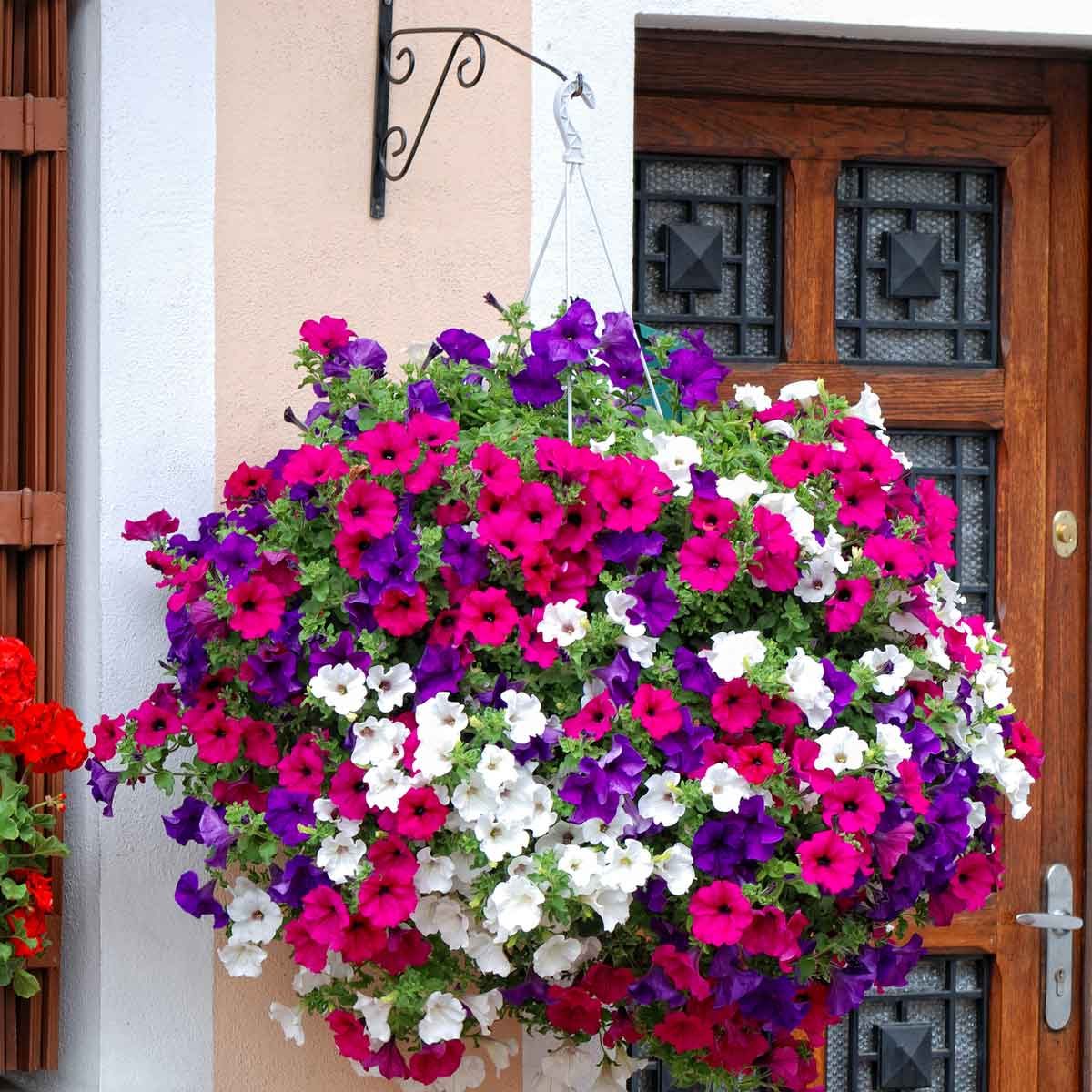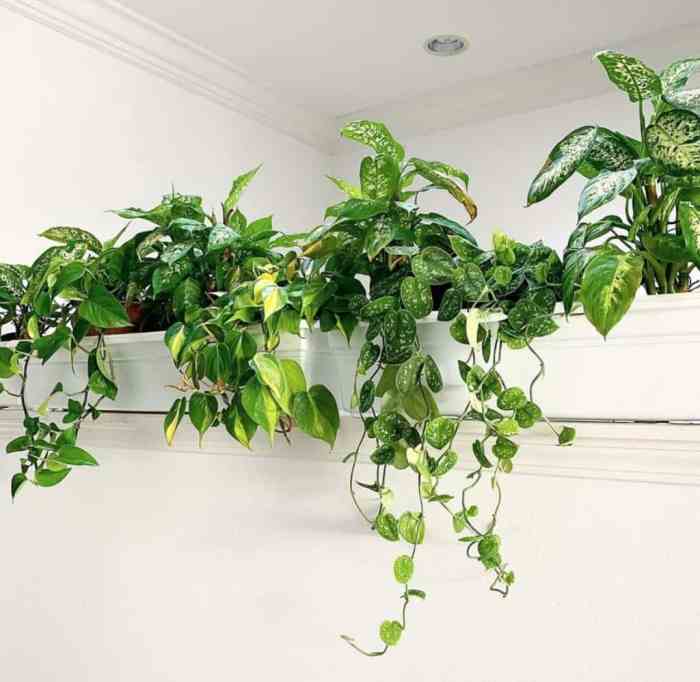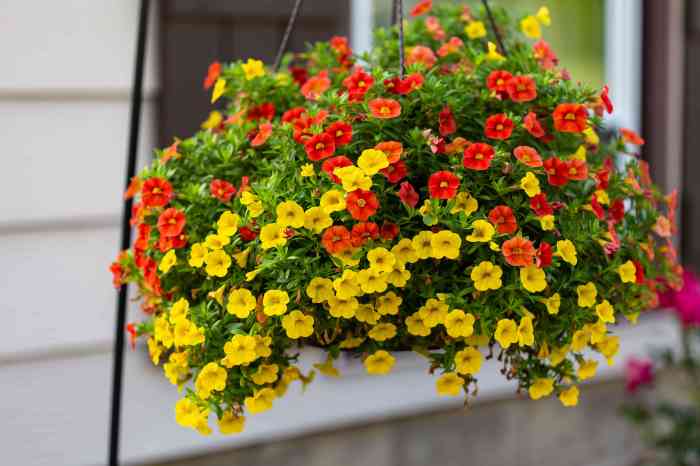Hanging plants live up to their name, bringing life and vitality to any space. Whether you’re a seasoned plant enthusiast or a novice gardener, these versatile wonders offer a plethora of benefits and creative possibilities.
From purifying the air to reducing stress, hanging plants enhance both your well-being and the aesthetics of your surroundings. Let’s delve into the world of hanging plants live, exploring their types, care, and innovative uses.
Types of Hanging Plants
Hanging plants add a touch of greenery and freshness to any indoor space. They come in a wide variety of shapes, sizes, and colors, making them suitable for any decor style. Some of the most popular hanging plants include:
- Pothos (Epipremnum aureum): Pothos is a fast-growing vine with heart-shaped leaves that come in a variety of colors, including green, yellow, and white. It is a low-maintenance plant that is tolerant of a wide range of light conditions and watering needs.
- Spider plant (Chlorophytum comosum): Spider plants are another easy-to-care-for hanging plant. They have long, narrow leaves that are variegated with white or cream. Spider plants produce small white flowers that are followed by plantlets, which can be rooted to create new plants.
- String of pearls (Senecio rowleyanus): String of pearls is a unique hanging plant with long, trailing stems that are covered in small, round leaves that resemble pearls. It is a slow-growing plant that prefers bright, indirect light and well-draining soil.
- Burro’s tail (Sedum morganianum): Burro’s tail is a succulent hanging plant with long, trailing stems that are covered in plump, blue-green leaves. It is a low-maintenance plant that prefers bright, indirect light and well-draining soil.
- Air plants (Tillandsia spp.): Air plants are unique hanging plants that do not need soil to grow. They absorb nutrients and water from the air through their leaves. Air plants come in a variety of shapes and sizes, and they can be displayed in a variety of ways, such as in terrariums, on driftwood, or in seashells.
When choosing a hanging plant, it is important to consider the size of the space, the amount of light available, and the level of care that you are willing to provide. With a little care, hanging plants can add a touch of beauty and freshness to any home or office.
Benefits of Hanging Plants

Hanging plants have become increasingly popular due to their aesthetic and practical benefits. These versatile plants can add a touch of greenery to any space, while also improving air quality and reducing stress levels.
Aesthetic Benefits
Hanging plants are a great way to add color and texture to a room. Their cascading vines and lush foliage can create a sense of movement and interest, making them a perfect choice for adding life to a dull corner or empty wall.
Practical Benefits
In addition to their aesthetic appeal, hanging plants also offer a number of practical benefits. Studies have shown that plants can help to improve air quality by removing toxins and increasing humidity levels. They can also help to reduce stress and anxiety by providing a calming and relaxing environment.
Using Hanging Plants in Different Spaces
Hanging plants can be used to enhance a variety of different spaces, including living rooms, bedrooms, and offices. In living rooms, they can be used to create a cozy and inviting atmosphere. In bedrooms, they can help to promote relaxation and sleep.
In offices, they can help to reduce stress and improve productivity.
Hanging plants live can add a touch of greenery and life to any indoor space. For those looking to add a trailing element to their indoor plant collection, real trailing plants indoor are an excellent option. These plants can cascade down from hanging baskets or shelves, creating a lush and inviting atmosphere.
With proper care and attention, hanging plants live can thrive and bring years of beauty and freshness to any home.
Hanging Plant Care: Hanging Plants Live

Nurturing hanging plants requires meticulous care to maintain their health and beauty. This entails regular watering, appropriate fertilization, and timely pruning.
Watering
Watering frequency depends on the type of plant, humidity, and season. Check the soil regularly and water when the top inch is dry to the touch. Use lukewarm water and avoid overwatering, as it can lead to root rot.
Fertilizing
Fertilize hanging plants monthly during the growing season with a balanced liquid fertilizer. Dilute the fertilizer to half strength to prevent nutrient burn.
Pruning
Regular pruning encourages healthy growth and prevents leggy, unkempt plants. Remove dead or yellowing leaves and stems. Pinch back trailing stems to promote fullness.
Common Problems
Hanging plants may encounter common issues such as pests, diseases, and nutrient deficiencies.
Pests
- Aphids: Small, soft-bodied insects that suck plant sap.
- Mealybugs: Cottony masses that attach to leaves and stems.
- Spider mites: Tiny, spider-like creatures that spin webs on leaves.
Diseases
- Powdery mildew: White, powdery growth on leaves.
- Root rot: Caused by overwatering, leading to soft, mushy roots.
- Botrytis blight: Grayish mold that affects leaves and flowers.
Nutrient Deficiencies
- Nitrogen deficiency: Yellowing leaves, stunted growth.
- Potassium deficiency: Brown leaf tips, weak stems.
- Iron deficiency: Yellowing leaves with green veins.
Troubleshooting
Identifying and resolving problems promptly is crucial for hanging plant health. Inspect plants regularly for signs of distress and take appropriate action:
- Pests:Use insecticidal soap or neem oil to control pests.
- Diseases:Remove infected plant parts and apply fungicides as directed.
- Nutrient deficiencies:Fertilize plants with a balanced fertilizer.
Creative Uses for Hanging Plants
Hanging plants are not just for adding a touch of greenery to your home. They can be used to create a variety of unique and stylish looks, both indoors and outdoors.One of the most popular ways to use hanging plants is to create a vertical garden.
This is a great way to add some greenery to a small space or to create a living wall. Vertical gardens can be made using a variety of materials, such as pallets, wire mesh, or even old picture frames.Hanging plants can also be used to create privacy screens.
This is a great way to add some privacy to your patio or balcony. Privacy screens can be made using a variety of plants, such as ferns, ivy, or bamboo.Hanging plants can also be used to create living art installations.
This is a great way to add some personality to your home or office. Living art installations can be made using a variety of plants, such as succulents, air plants, or orchids.Hanging plants can also be used to enhance special events, such as weddings and parties.
Hanging plants live is a great way to add life to your home. They can purify the air, add a touch of nature, and create a relaxing atmosphere. However, if you don’t have a lot of natural light, you may need to use grow light for hanging plants to help them thrive.
Grow lights can provide the necessary light that plants need to grow and stay healthy, even in low-light conditions. With the right grow light, you can enjoy the benefits of hanging plants live all year round.
They can be used to decorate the ceremony or reception area, or they can be given as gifts to guests.
Hanging Plants for Special Occasions
Hanging plants are a beautiful and versatile way to add some extra flair to your special event. They can be used to create a romantic atmosphere at a wedding, or they can add a touch of whimsy to a party.
Here are a few ideas for using hanging plants at your next special event:
- Hang them from the ceiling to create a canopy of greenery.
- Use them to decorate the archway or gazebo where the ceremony will be held.
- Place them on tables or chairs to add a touch of color and life.
- Give them as gifts to guests as a unique and memorable way to say thank you.
Hanging Plant Design
Hanging plants can add a touch of elegance and greenery to any space. But to create a truly stunning display, it’s important to consider the principles of hanging plant design.
Balance and Proportion
When arranging hanging plants, it’s important to consider the balance and proportion of the display. A good rule of thumb is to use a variety of plant sizes and shapes to create a visually appealing arrangement. For example, you might use a large trailing plant in the center of the display, with smaller plants suspended around it.
Color Theory
Color theory can also be used to create a visually appealing hanging plant display. For example, you might use plants with complementary colors to create a striking contrast, or you might use plants with similar colors to create a more harmonious look.
Selecting the Right Plants, Hanging plants live
The type of plants you choose for your hanging display will depend on the amount of light and water available in the space. For example, if you have a bright, sunny space, you might choose plants that require a lot of light, such as ferns or orchids.
If you have a darker space, you might choose plants that can tolerate low light levels, such as snake plants or ZZ plants.
Arranging Hanging Plants
Once you’ve selected the right plants for your hanging display, it’s time to arrange them. There are a few different ways to do this, depending on the size and shape of your plants.* For a simple display, you can simply hang the plants from the ceiling at different heights.
- For a more creative display, you can use a variety of hooks and hangers to create a more complex arrangement.
- You can also use a plant stand to display your hanging plants. This can be a good option if you don’t have a lot of ceiling space.
No matter how you choose to arrange your hanging plants, the most important thing is to create a display that is visually appealing and that complements the style of your home.
Wrap-Up

Hanging plants live are not just decorative accents; they are living works of art that transform spaces, purify the air, and bring a touch of nature indoors. Whether you’re a seasoned plant parent or just starting your green journey, embrace the beauty and benefits of hanging plants live to elevate your living spaces.
Question & Answer Hub
How often should I water hanging plants?
Water when the soil is slightly dry to the touch, typically every 7-10 days.
What are some common pests that affect hanging plants?
Aphids, mealybugs, and spider mites are common pests.
Can hanging plants survive in low light?
Yes, certain plants like pothos and snake plants can tolerate low light conditions.